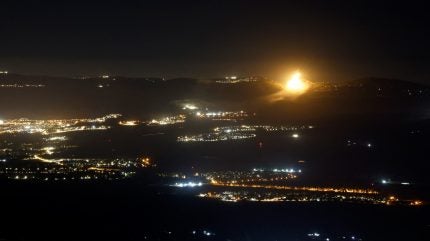
Iran is likely to launch a large-scale drone and missile attack on Israel across four fronts in response to Israel killing Hamas’ political leader Ismail Haniyeh in Tehran last week, according to conflict analysts and Iranian state media.
Iran and its ‘Axis of Resistance’ could strike as soon as today (5 August), US Secretary of State Antony Blinken has reportedly told G7 members.

Discover B2B Marketing That Performs
Combine business intelligence and editorial excellence to reach engaged professionals across 36 leading media platforms.
Tehran will coordinate Lebanese political militia Hezbollah, the armed Yemeni Houthi group, Iranian-backed Iraqi militias and Iranian forces conducting simultaneous strikes in a ‘quadrilateral operation’ on Israel, Iran’s state media reported yesterday (4 August).
Hezbollah wants revenge for Israel killing top military commander Fuad Shukur in an airstrike in southern Beirut last week, while the Houthis seek to retaliate for an Israel Defense Forces (IDF) airstrike which killed Houthi military personnel in al Hudaydah, Yemen, on 20 July.
On the fourth front, leader of Iranian-backed Iraqi militia Harakat Hezbollah al Nujaba, Akram al Kaabi, published an image yesterday (4 August) on Telegram indicating his intent to attack Israel.
Nasser Kanaani, spokesperson for the Iranian Foreign Ministry, said today (5 August) that Tehran was not seeking a wider conflict in the region, but that “punishing Israel is necessary”.

US Tariffs are shifting - will you react or anticipate?
Don’t let policy changes catch you off guard. Stay proactive with real-time data and expert analysis.
By GlobalDataHow will this Iranian attack differ from the last?
Overarchingly, this attack will involve a larger number of launch and target locations, according to the Institute for the Study of War (ISW).
When Iran attacked Israel for the first time on 13 April, the 170 one-way attack drones, 120 ballistic missiles, and 30 cruise missiles Tehran launched came from within Iranian territory, giving the US and Israeli forces significantly more time to intercept them.
Projectiles fired from Lebanon, Yemen or Iraq would be far trickier for even Israel’s renowned ‘Iron Dome’ defence system to intercept. This would also allow Iran to hit a greater number of targets across Israel.
The ISW also said Iran “could order simultaneous attacks on US forces, especially in eastern Syria”.
Likely to come from Iranian-backed militia, attacks on strategic US positions in Syria could divert the US’ attention and resources away from intercepting Israel-bound missiles.
US Defence Secretary Lloyd Austin met with Israeli counterpart Yoav Gallant yesterday (4 August) to discuss Israel’s defensive preparation, but Blinken has admitted the US is unclear what form Iran’s retaliation will take.
Iran’s window to attack Israel without serious US involvement shrinks as Washington moves military assets to the Middle East. The US has deployed naval cruisers and destroyers, a carrier strike group and a squadron of fighter jets to the region amid escalating tensions.
Criticism over US support for Israel grows stronger as Gallant, Prime Minister Benjamin Netanyahu and the Israeli war cabinet continue their offensive in Gaza, where more than 39,000 Palestinians have been killed.
Yesterday (4 August), an IDF airstrike hit two schools and a hospital complex in Gaza on Sunday, killing at least 30 people.
War with Iran, Hezbollah and Hamas has become a political lifeline for Netanyahu, whose popularity is at an all-time low. The end of the multifront Middle East conflict would likely collapse his far-right coalition government and trigger early elections in Israel, currently set for 2026.
A tragic, drawn-out conflict looks poised to spill across borders.





